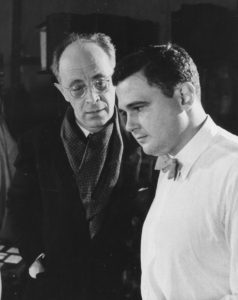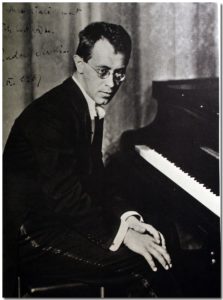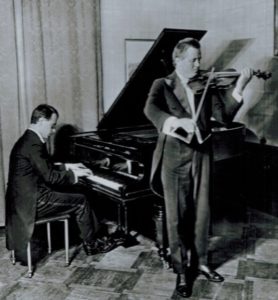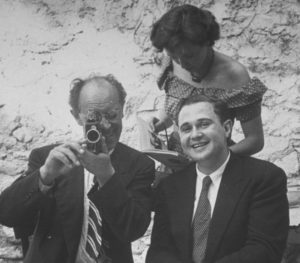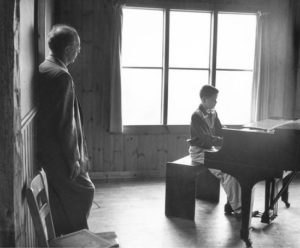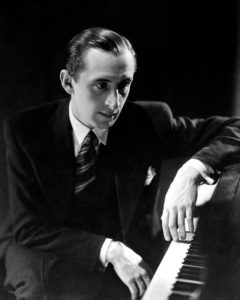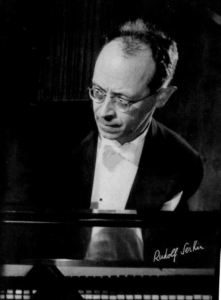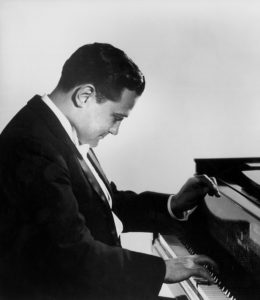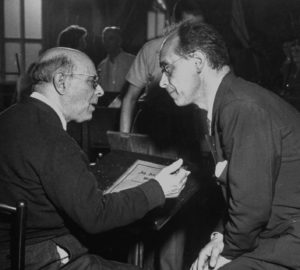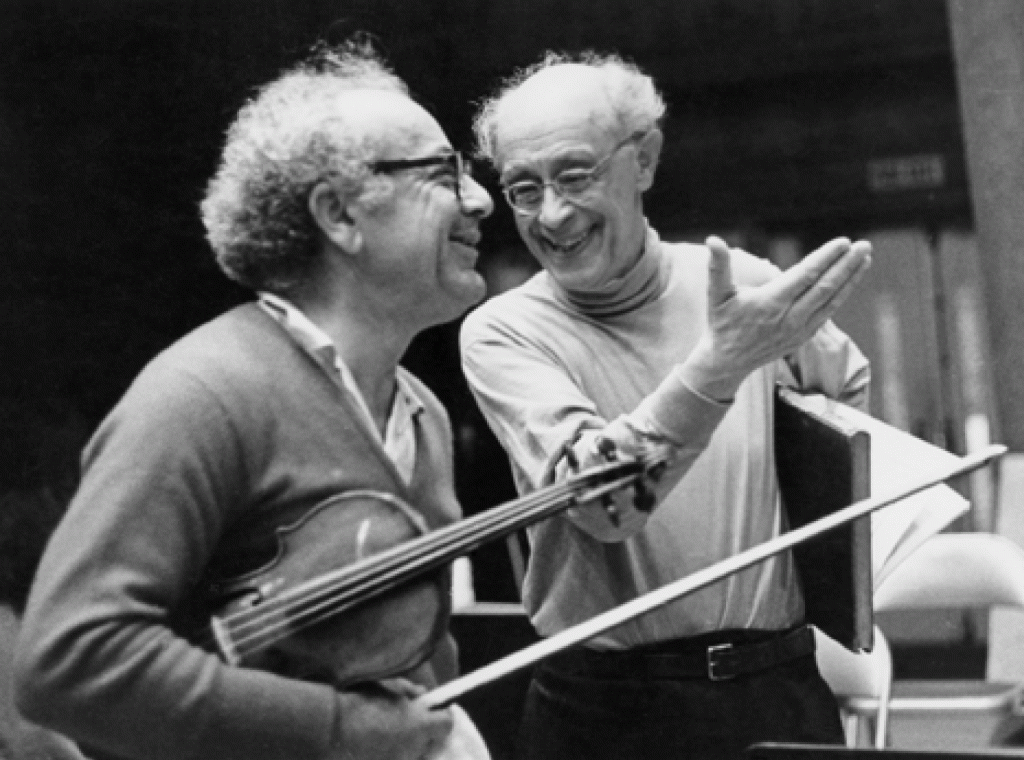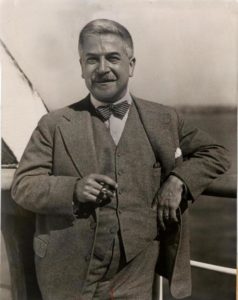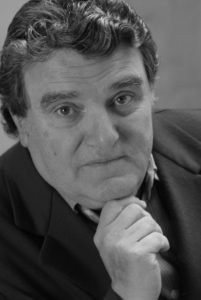“Serkin was my teacher, for better or for worse! He taught me discipline and Calvinism, when I was a young libertine. My father, following the tradition of Peter the Great, had decided that after my initial Russian education I needed a Germanic influence. Discipline and rigor became the watchwords, replacing freedom and fantasy.” (1)
“As a child, my model was Rubinstein! I wanted to imitate him! Sometimes I would go to the piano and pretend to play while listening to his records. I idolized him! When I arrived at Curtis, I had to replace Rubinstein with Serkin, silence my own temperament which was more lyrical and sensual, and curb my panache. What happened then was that thanks to a natural intellectual flexibility, I was able to absorb the completely new world he opened up for me. I imitated him, I was inspired by him, and later I rejected him, in part…” (1)
The clash of personalities
How can we imagine two more different personalities than Serkin and Istomin? How is it possible to conceive that they could understand each other? Their only common point is trivial: Serkin’s father was also of Russian origin and initially made a living by singing, just as Istomin’s parents had done when they arrived in America.
Istomin was born in New York and as an only child was spoilt and overprotected by his family. He was quick to win the affection and admiration of his entourage and to indulge in it. Serkin was born in Bohemia, the fifth of eight children, and had grown up in very difficult material and emotional conditions.
Serkin had a German education, for language and music. Istomin had been educated in the Russian style, with complete freedom. Serkin was not a born virtuoso, whereas Istomin was. Serkin had been successful in his first concerts, but at the age of 15 began to study with Schoenberg. He only played in public for two years in the Society for Private Musical Performances, which his master had just created and where applause was banned.
Serkin had long been confined to a career in chamber music along with Adolf Busch. His ideal was to be a humble servant of music, and to achieve the highest possible level of musical truth and pianistic perfection through hard work and suffering. For Istomin, it was self-evident that his path was to become a great soloist. He was conscious that he would have to work hard, but he thought that this work would be based on instinct and pleasure.
Despite his shyness, Serkin was very approachable and friendly. At first sight, Istomin could seem gruff. A very rigorous musician, Serkin could behave on stage as though he were “possessed” by the Devil himself. On the contrary, Istomin tried not to let anything appear on his face, allowing any emotion to arise purely as a consequence of the music. When they played Mendelssohn, Serkin was incomparable at lending incredible tension to the Rondo Capriccioso, while Istomin brought unique lyricism to the Songs without Words.
The teachings of Serkin
Serkin wanted to discipline this spoiled child, this brilliantly gifted young savage – but he did not quite know how to go about it, as he had just begun his career as a teacher. His priority was to make Istomin aware of the demands of his art, and of the performer’s duties- regardless of whether this would lead to a recurrent feeling of guilt. Serkin was obsessed with the waste that a failure of his teaching would represent, given his student’s talent. As for Istomin, he was completely unprepared to hear this moralizing speech. He began to question himself deeply and lost some of his bearings and a part of his trust. The result could have been catastrophic – but fortunately was not, thanks to their mutual efforts.
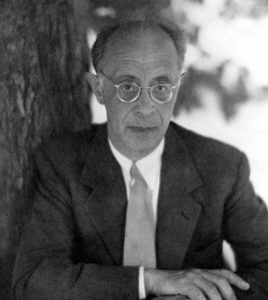 Serkin’s first requirement was absolute adherence to the text, both musically and pianistically. No freedom was allowed, not even the idea of redistributing a musical phrase between both hands to make it more “playable”. Istomin was not used to such demands and on occasion, this caused Serkin to fly into a rage. It began with the very first piece which Serkin asked him to work on, the Beethoven Sonata ”Pathétique”. After Istomin finished playing it at the lesson, Serkin berated him: “That was terrible! Didn’t you practice? How much did you practice?” Istomin replied with candor: “Well, I played through the whole piece and thought it sounded really good, so I didn’t think I needed to practice it more.” (2) Years later, Serkin used to enjoy telling this tale of innocence, but at the time he was beside himself with rage.
Serkin’s first requirement was absolute adherence to the text, both musically and pianistically. No freedom was allowed, not even the idea of redistributing a musical phrase between both hands to make it more “playable”. Istomin was not used to such demands and on occasion, this caused Serkin to fly into a rage. It began with the very first piece which Serkin asked him to work on, the Beethoven Sonata ”Pathétique”. After Istomin finished playing it at the lesson, Serkin berated him: “That was terrible! Didn’t you practice? How much did you practice?” Istomin replied with candor: “Well, I played through the whole piece and thought it sounded really good, so I didn’t think I needed to practice it more.” (2) Years later, Serkin used to enjoy telling this tale of innocence, but at the time he was beside himself with rage.
One of Serkin’s most spectacular rages was over the Brahms First Concerto. Istomin had heard Serkin perform it with the New York Philharmonic, conducted by John Barbirolli, and was so impressed that he decided to prepare the first movement and play it for Serkin. He had worked hard on the tricky passages, but had neglected to spend adequate time on some of the passages which were technically less demanding. Serkin brandished his chair and threatened to throw it in his face: “Aren’t you ashamed to treat such a masterpiece like this?” (1)
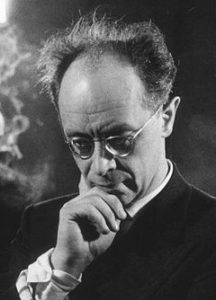 As soon as music was no longer the issue, Serkin was charming and paid a great deal of attention to his students, lending a sympathetic ear to their personal problems. One evening he invited two of his students, Eugene Istomin and Byron Hardin, to dinner at his home. The meal took place in a very relaxed atmosphere, but then things went awry. Istomin had brought along some recordings of Vladimir Horowitz, including the Rachmaninoff Prelude Op. 23 No. 5 recorded in Berlin in 1931. He suggested they listen to it, prefacing this with: “It’s a real disaster – it’s Horowitz playing, and there are a million wrong notes!” Serkin was infuriated – “How dare you talk like that? He’s the greatest pianist in the world!” – upon which he ejected the two impudent youngsters who thought they could poke fun at the imperfections of their glorious elders.
As soon as music was no longer the issue, Serkin was charming and paid a great deal of attention to his students, lending a sympathetic ear to their personal problems. One evening he invited two of his students, Eugene Istomin and Byron Hardin, to dinner at his home. The meal took place in a very relaxed atmosphere, but then things went awry. Istomin had brought along some recordings of Vladimir Horowitz, including the Rachmaninoff Prelude Op. 23 No. 5 recorded in Berlin in 1931. He suggested they listen to it, prefacing this with: “It’s a real disaster – it’s Horowitz playing, and there are a million wrong notes!” Serkin was infuriated – “How dare you talk like that? He’s the greatest pianist in the world!” – upon which he ejected the two impudent youngsters who thought they could poke fun at the imperfections of their glorious elders.
Istomin had naively imagined that Serkin, who seemed musically so far away from Horowitz, would go along with this game. Actually, there was mutual admiration and friendship between the two men. Serkin had supported Horowitz during the nervous breakdown which affected him between 1936 and 1938. He came almost every day in the summer of 1937, playing two pianos with him, extolling his sight reading or his performance of the fugue from Beethoven’s Hammerklavier Sonata. As for Horowitz, he once said that if he had not been Horowitz he would have wanted to be Serkin. However, the reason for Serkin’s great anger was not due to the solidarity between great artists, but rather the unacceptable arrogance of these two apprentice pianists, whose only excuse was the unconsciousness of youth. More than fifty years later, Istomin still felt a bit ashamed.
Often asked about his years of study with Serkin, Istomin resorted to religious terms to describe them: mysticism, possession, mission, self-effacement, sacrifice, ecstasy, Calvinism… At the time, Serkin’s intention was to make his students realize the necessity of dedicating themselves body and soul to Music, for which they would have to suffer, renounce all traces of egoism, and refuse to seduce. These sacrifices were indispensable for being able to approach as closely as possible the goal of inaccessible truth and perfection. In many ways, it resembled the act of taking religious orders.
The temptations of taking the easy way out
Compliments were almost absent from Serkin’s language – but if he did offer any, they were designed to make Istomin feel guilty. Serkin often told him: “You should play this work better than me – you’re more gifted than I am”. Serkin wanted to avoid giving students the feeling that they had reached a goal. The moment one stops researching, the fall is certain.
All Serkin’s students agree that it was out of the question for him to prepare them for a “career”. His mission was to lead them down the steep paths of the musical ideal. Promotion, competitions, engagements were trivial concerns which meant little or nothing to Serkin – it was up to his students to deal with them! He thought that if they had talent and a serious sense of purpose and perseverance, they would find a way to launch their own careers. Istomin was probably the only student he decided to help. He arranged two recitals for him in Basel and Zurich in 1950 which he guaranteed with his own money. He also intervened when Istomin recklessly defied Judson, the most powerful manager of the time. There were other occasions when Serkin showed his high esteem for his former student. In 1945, in Chicago, when he was invited to be the soloist in a major concert with Adolf Busch’s Chamber Players, he refused to take the place of Istomin, who was the soloist on the tour, and instead offered to play Mozart’s Concerto for Two Pianos with him. In Prades, in 1950, when he refused to record the Bach Fifth Brandenburg with Casals in order not to overshadow the version he had recorded with Busch before the War, he suggested that Istomin, and not Horszowski, replace him.
Serkin was obsessed by the thought that Istomin might let success go to his head and take the easy way out. It was a leitmotiv in his correspondence, and he often tried to downplay or even prevent Istomin’s successes! At the 1943 Leventritt Competition, he not only abstained from voting, which was customary when a member of the jury was confronted with one of his own students, but even suggested to the other members of the jury that Istomin was not ready and that it might be better not to award him the Prize! Istomin’s debut at Carnegie Hall with the New York Philharmonic in November 1943 was very successful, despite the stressful conditions, which included a last-minute change of piano and paralyzing stage fright made even worse by the live broadcast. Istomin was aware that he could have played better in some passages, but the reception was tremendous, and he was called back on stage five times to acknowledge the applause. He received rave reviews in all the New York papers and the renowned musicians Adolf Busch and Bronislaw Huberman showed great enthusiasm. As for Serkin, true to form, he presented him with a recording of the concert: “I brought you the acetate disks, so that you can hear for yourself how badly you played.” (1)
Serkin’s contradictions
Some of Serkin’s contradictions remained unexplained for Istomin. As a piano teacher, Serkin was extremely strict, but in Marlboro he created a space of great freedom and a republic of equals, where distinguished elders and talented young musicians were considered to be nearly on the same level for playing chamber music together! For Istomin, this contradiction resembled Casals. The two great musicians were very open-minded when it came to chamber music, but inflexibility took over when they were teaching their own instrument.
Istomin felt that both aspects of Serkin were excessive – too much severity on one hand, and too much equality on the other. He felt that Marlboro’s project had deviated from Busch’s initial ideas. Busch himself remained a type of Herr Professor. Istomin would have preferred to keep a clearer distinction between “master” and “apprentice”, but nevertheless, this did not diminish his pleasure in coming to Marlboro for six summers between 1957 and 1986.
Serkin’s teaching was both highly inspiring and deeply frustrating: “Studying with Serkin was sublime, but also very dangerous. He was both a hero and an excoriating conscience.” (1) For Istomin, it was a terrible shock, both humanly and musically. He always looked back with mixed feelings on this education, feeling torn between pride and resentment. From time to time, he was invaded by a sense of nostalgia for his lost freedom and hedonism. He had embraced Serkin’s morality of suffering and humility and his demands for perfection. He could not part from it, but he sometimes felt it was a burden.
In order to find his own way, Istomin needed some antidotes to counterbalance Serkin’s strictness. Some of these he found outside the piano, thanks to his love of singing (Serkin paid little attention to cantabile) and his fascination for Heifetz. He also found them in other pianists -Schnabel for his freedom of phrasing, and Rachmaninoff for his richness of sound and impassibility at the keyboard.
Serkin often worried that he was not giving Istomin the type of education he needed in order to fully develop. In April 1944, he wrote to Byron Hardin, reporting the success of Istomin’s first New York recital, and adding that “he has not worked much since, and is still a mixture of music lover, amateur, and tremendously gifted child.” He confessed his doubts: “Maybe I am not the right teacher for him. Maybe he needs force. Maybe he should have needed a Mr. Saperton or Madame Isabella (Vengerova) to make him work continuously and concentrated.” (3)
Unanswered questions and conclusion
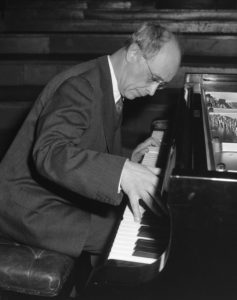 However, Istomin always retained an immense admiration for Serkin, for the incandescence of his playing, his asceticism, his musical honesty, and his quest for truth: “He had an unconditional reverence for the composers he played, and his struggle to get the composer’s meaning was fierce. Of all the musicians I’ve ever known, it was Serkin who was the most intensively unbending in this way. ‘Better to fall on your face in honest striving than to have a cheap success’.” (1)
However, Istomin always retained an immense admiration for Serkin, for the incandescence of his playing, his asceticism, his musical honesty, and his quest for truth: “He had an unconditional reverence for the composers he played, and his struggle to get the composer’s meaning was fierce. Of all the musicians I’ve ever known, it was Serkin who was the most intensively unbending in this way. ‘Better to fall on your face in honest striving than to have a cheap success’.” (1)
There was also a great deal of affection and intellectual and political complicity on both sides, which manifested itself notably in Humphrey’s presidential campaign and their common interest regarding the theories of Toynbee. Istomin never missed out on the chance to attend a Serkin concert whenever he could, nor on an opportunity to meet him (he visited him in Marlboro even when his schedule did not allow him to participate in the Festival).
In the end, a troubling question remains: what would Istomin have become if he had not studied with Serkin? There are some who regret that he did, such as Jean-Bernard Pommier, who felt that Serkin had not really been a teacher: “He listened, he punished, but he said nothing.” (4) Pommier noted that Serkin had not provided his student with any method of musical analysis, any process for learning new works, or a way to improve his piano technique. He assumed that Istomin would know all this when he came to study with him – but he didn’t! Serkin thought it was up to the student to find ways to achieve the musical ideals of which he made them aware. Others thought that the musical Jansenism which Serkin had instilled in him was so contrary to his temperament that it would permanently restrict his personal development, even though he seemed to have distanced himself from his master’s dogma.
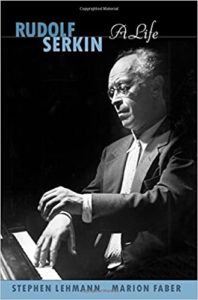 What kind of pianist would Istomin have become if he had stayed with Siloti? What would have happened if he had worked with Robert Casadesus? If he had joined Olga Samaroff or Rosina Lhevinne at the Juilliard School? It is of course impossible to answer such questions. We can only try to imagine and dream.
What kind of pianist would Istomin have become if he had stayed with Siloti? What would have happened if he had worked with Robert Casadesus? If he had joined Olga Samaroff or Rosina Lhevinne at the Juilliard School? It is of course impossible to answer such questions. We can only try to imagine and dream.
As for Istomin himself, he concluded his contribution to the biography of Serkin published by Stephen Lehmann and Marion Faber with these words: “Let us remember that he influenced the great generation of American pianists in the second half of the 20th century. Not a single one of them remained insensitive to his musical integrity.” (5)
Documents
Beethoven. Sonata No. 8 op. 13 “Pathétique”, first movement. Rudolf Serkin. Recorded by Columbia in 1945. An intense performance which explains why Serkin was not satisfied with the first-sight reading of young Istomin!
.
Mendelssohn. Rondo Capriccioso Op. 14. Rudolf Serkin. Recorded live at the Library of Congress on May 5, 1948.
.
Filmed interview with Isaac Stern in 1973, which reveals Serkin’s kindness and sense of humor.
.
Notes
- Quotations from interviews with Bernard Meillat between 1987 and 1991
- James Gollin. Pianist; A Biography of Eugene Istomin, page 43
- James Gollin. Pianist; A Biography of Eugene Istomin, page 85
- Interview with Bernard Meillat in 2006
- Stephen Lehmann & Marion Faber. Rudolf Serkin, A Life, page 201
Eugene Istomin also told Robert Dumm about his musical education. The article was entitled “My Teenage Years with Serkin” and published in Clavier (July-August 2004).

